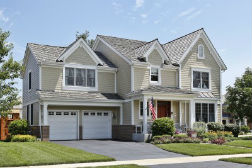Case-Shiller: Home Price Growth Expands to All Metro Areas
 March home prices were again dominated by the Northwest with Portland, Oregon posting a year-over-year gain of 12.30 percent followed by Seattle, Washington’s year-over-year gain of 10.80 percent.
March home prices were again dominated by the Northwest with Portland, Oregon posting a year-over-year gain of 12.30 percent followed by Seattle, Washington’s year-over-year gain of 10.80 percent.
Denver, Colorado rounded out the top three cities with a year-over-year gain of 10.00 percent. San Francisco, California, which consistently posted double-digit gains in recent months slipped to a year-over-year gain of 8.50 percent. This may indicate that prices in high cost metro areas are nearing their peak.
S&P Dow Jones Chair David M Blitzer attributed outsized price gains to the shortest supply of available homes since the mid-1980s. Homes for sale account for only two percent of U.S. households. To put rapidly increasing home prices in context, the S&P Case-Shiller 20-City Home Price Index was 11.50 percent below its peak in March, 2006.
Case-Shiller’s 20-City Home Price Index posted a 5.40 percent gain year over year, which was equal to its year-over-year price gain in March 2015. Month-to month home prices gained 0.90 percent; analysts had estimated year-year growth of 5.10 percent and a month-to-month gain of 0.70 percent. All cities in the 20-City Housing Market Index posted gains in month-to-month and year-over-year readings.
Pending Home Sales Exceed Expectations
Pending home sales in April supported trends noted in Case-Shiller’s 20-City Home Price Index. Regional results for pending home sales in April rose by 1.20 percent in the Northeast while pending sales were unchanged in the Midwest. The South posted pending sales gain of 6.80 percent and the West recovered with an 11.40 percent rise in pending sales for April.
Based on April’s pending home sales readings, real estate pros expect a jump in closed sales in May. Home buyer demand remains resilient according to Lawrence Yun, chief economist for the National Association of Realtors. Mr. Yun also said that the key to continued expansion of home sales is providing buyers sufficient supplies of affordable homes. Builders may provide relief by increasing construction, but have cited shortages of labor and developed land as constraints on new construction. Active demand for high-end homes has also focused construction on higher priced homes.
Mortgage applications are also increasing, which indicates that more homes are being purchased by owner-occupant buyers than investors. Relatively low mortgage rates and waning investor interest could provide buyers relying on financing a leg-up in competing for available homes.

 Home prices were 5.70 percent higher year-over-year in January according to S&P Case-Shiller’s 20-City Home Price Index. Top year-over-year gains were posted by Portland, Oregon at 11.80 percent, San Francisco, California at 10.80 percent and Seattle Washington posted a year-over-year gain of 10.70 percent. Denver, Colorado, which had top gains in recent months, posted year-over-year home price growth of 10.20 percent.
Home prices were 5.70 percent higher year-over-year in January according to S&P Case-Shiller’s 20-City Home Price Index. Top year-over-year gains were posted by Portland, Oregon at 11.80 percent, San Francisco, California at 10.80 percent and Seattle Washington posted a year-over-year gain of 10.70 percent. Denver, Colorado, which had top gains in recent months, posted year-over-year home price growth of 10.20 percent. Week in Review
Week in Review